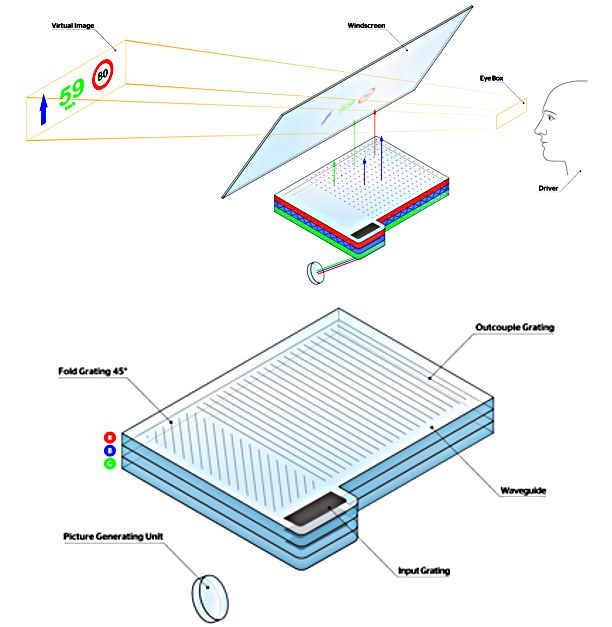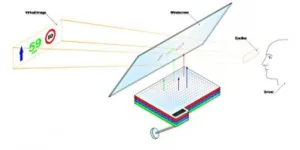Continental AG (Germany) has teamed with DigiLens Inc. (Sunnyvale, CA) to produce a demonstrator that is claimed to be the industry’s first full color, automotive specific Augmented Reality Head-Up Display (AR HUD) that is based on waveguide technology.
First, a few words of background information.
The company distinguishes an AR HUD system from a conventional HUD. The principle difference between the two is the angular size of the image projected by the system. The angular size of an AR HUD is considerable larger than that of a conventional HUD. The company proposes that automotive applications are best served by an AR HUD.
The optical configuration of a conventional HUD system generally includes the use of a mirror. More specifically, an automotive HUD that uses the windshield as the combiner falls into this category. It is found, however, that designs and technologies that work well in conventional windshield HUD systems are not well suited for use in windshield AR HUD systems. One of several reasons for this is that a conventional windshield HUD has a volume of 3 to 4 liters. In the AR HUD application, the use of similar mirror technology inevitably leads to an AR HUD system that has a volume of the order of 30 liters. Physical space limitations inherent to most vehicle dashboards make it impossible to allocate this much volume to implement a conventional mirror-based AR HUD system.
The team’s approach to addressing this issue and in producing a compact AR HUD is based on replacing the mirror with an optical component built with waveguide technology.
As described on the company website, the waveguide production process developed by DigiLens includes the “printing” of light manipulating structures into a thin and transparent material. Within a waveguide using this material, light can be guided along the plane of the waveguide and be made to project perpendicular to the plane of the waveguide. The video appended at the end of this article contains a recent presentation discussing the company’s so-called switchable Bragg grating material and the application of the technology to waveguide applications.
The configuration of the demonstrator AR HUD system is illustrated in the figures below. Light rays from a projector enter the waveguide assembly from below. The waveguide assembly consists of three flat, stacked waveguide components. One waveguide is for red light, one for green light and one for blue light. Light rays are folded inside the waveguide components and projected upwards out of the waveguide assembly to eventually produce a virtual image by reflection off the surface of the vehicle windshield.
 Top: Configuration of the demonstrator AR HUD system. Bottom: Detail of the components in the waveguide assembly.
Top: Configuration of the demonstrator AR HUD system. Bottom: Detail of the components in the waveguide assembly.
Development work by the team has resulted in a full color demonstrator having an angular viewing area that is 15 degrees x 5 degrees (which translates to 2.60 meters X 0.87 meters at a projection distance of 10 meters). At the same time, system volume is only 10 liters. Given this modest volume requirement, integration of an AR HUD system into a dashboard now becomes a possibility in a wide range of automotive vehicles.
Company literature reports that the waveguide technology also has potential for use in aviation applications and in motorcycle helmets.
In other, related company news, DigiLens reports having raised an additional $25 million from Continental. The deal gives Continental an 18 percent stake in DigiLens. DigiLens has now raised a total of $60 million. -Arthur Berman
Continental, Sebastian Fillenberg, +49 6196 87-3709, [email protected]

